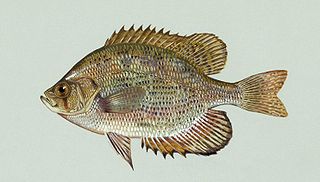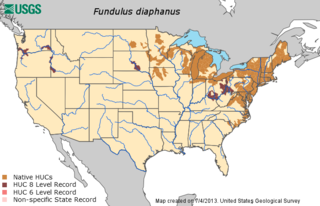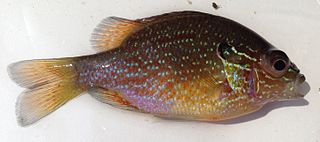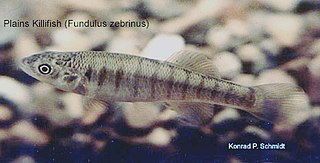
Centrarchidae, better known as sunfishes, is a family of freshwater ray-finned fish belonging to the order Perciformes, native only to North America. There are eight universally included genera within the centrarchid family: Lepomis, Micropterus, Pomoxis (crappies), Enneacanthus, Centrarchus, Archoplites, Ambloplites, and Acantharchus. A genetic study in 2012 suggests that the highly distinct pygmy sunfishes of the genus Elassoma are also centrarchids.

The bluegill, sometimes referred to as "bream", "brim", "sunny", or "copper nose" as is common in Texas, is a species of North American freshwater fish, native to and commonly found in streams, rivers, lakes, ponds and wetlands east of the Rocky Mountains. It is the type species of the genus Lepomis, from the family Centrarchidae in the order Perciformes.

The pumpkinseed, also referred to as pond perch, common sunfish, punkie, sunfish, sunny, and kivver, is a small/medium-sized North American freshwater fish of the genus Lepomis, from family Centrarchidae in the order Perciformes.

The warmouth is a freshwater fish of the sunfish family (Centrarchidae) that is found throughout the eastern United States. Other local names include molly, redeye, goggle-eye, red-eyed bream, and strawberry perch.

The redbreast sunfish is a species of freshwater fish in the sunfish family of order Perciformes. The type species of its genus, it is native to the river systems of eastern Canada and the United States. The redbreast sunfish reaches a maximum recorded length of about 30 centimetres (12 in).

The banded killifish is a North American species of temperate freshwater killifish belonging to the genus Fundulus of the family Fundulidae. Its natural geographic range extends from Newfoundland to South Carolina, and west to Minnesota, including the Great Lakes drainages. This species is the only freshwater killifish found in the northeastern United States. While it is primarily a freshwater species, it can occasionally be found in brackish water.

The blackstripe topminnow, Fundulus notatus, is a small freshwater fish in the family Fundulidae, found in central North America.
The Barrens topminnow is an endangered species of freshwater fish in the family Fundulidae. There are many potential causes of decline of this species including the invasive western mosquitofish that will replace native species on a population level, wading piscivorous birds that prey on adults, and the overall restricted distribution of the species. Managing for this species is vital for its success, but to do so there must be an understanding of the species' characteristics. It is endemic to a small portion of Tennessee in the Elk River and West Hickory Creek in the Cumberland River drainage. The life span of F. julisia is very short, living up to only 3 years. In many cases the majority of the population does not even reach that age. Most adult males are eaten by birds because of their bright coloration during breeding season. Current management plans are in place for the improvement of the species such as captive breeding and reintroduction, and also private management of streams and land. Yet, more can be done to aid them in their survival efforts. Buffer zones around streams can be created to promote the health of the stream and close observation of the introduced populations needs to be a priority. With only three small original populations left in the wild it is important that species survive in captivity, but more so in its natural environment.
The blackspotted topminnow, Fundulus olivaceus, is a species of fish in the family Fundulidae: the topminnows and North American killifishes. It is native to the south-central United States, where it is known from the drainages of the Mississippi River from Illinois to the Gulf of Mexico and as far west as Galveston Bay.

The southern studfish is a ray-finned fish of the family Fundulidae, the tooth carps, that is native to the southeastern United States.

The dollar sunfish is a species of freshwater fish in the sunfish family of order Perciformes. It is categorized as a warm water pan-fish. Early settlers said that this species of sunfish resembled a European species they called bream. Historically it has been found along the Southern Atlantic coastal drainages from North Carolina to Florida, and west to Texas. Lepomis marginatus mainly feeds on detritus and filamentous algae as well as a few terrestrial insects. The juvenile and mature fish do not have many predators, but the eggs in the nest are in danger of predation from a few different species of fish.

The redspotted sunfish, also known as a stumpknocker, is a species of freshwater ray-finned fish, a sunfish from the family Centrarchidae which is native to the United States. The redspotted sunfish was previously considered to be a western subspecies of spotted sunfish but was distinguished as a separate species by Warren in 1992.

The plains topminnow is a species of freshwater topminnow found in North America. The fish has a small range within the United States of America which consists of two major populations.

The Gulf killifish is one of the largest members of the genus Fundulus; it is capable of growing up to 7 inches (18 cm) in length, whereas the majority of other Fundulus reach a maximum length of 4 inches (10 cm). Therefore, F. grandis is among the largest minnows preyed upon by many sport fish, such as flounder, speckled trout, and red drum. Fundulus derives from the Latin meaning "bottom," and grandis means "large". The Gulf killifish is native to the Gulf of Mexico from Texas to Florida and the eastern coast of Florida and the Caribbean Sea in the Atlantic Ocean. Threats to the survival of the Gulf killifish include extreme changes in salinity, changes in temperatures, and toxic events such as the hypoxic dead zone in Louisiana and the Deepwater Horizon oil spill. The Gulf killifish is currently being used to test the effects of oil and oil dispersants on the physiology of marine species affected by these substances. This is significant to conservation biology, because with the continued extraction of oil and other natural resources from North American waters, it has become increasingly important to understand the risks and consequences in worst-case scenarios, such as the Deepwater Horizon oil spill, and the lasting effects on the marine ecosystem.

The bayou killifish or bayou topminnow is a topminnow-like fish that thrives primarily in the shallow waters off the shores of the Americas, as well as fresh and brackish waters. Feeding off of small vertebrates and invertebrates, this fish displays reproduction techniques unique to its species.

Fundulus zebrinus is a species of fish in the Fundulidae known by the common name plains killifish. It is native to North America, where it is distributed throughout the Mississippi River, Colorado River, and Rio Grande drainages, and other river systems; many of its occurrences represent happy introduced populations.

Fundulus nottii, the bayou topminnow or southern starhead topminnow, is a fish of the family Fundulidae found in the southeastern United States.

The rosefin shiner is a species of fish native to the United States. The fish is omnivorous and lives in freshwater rivers and creeks in Virginia, North Carolina and West Virginia.

Fundulus luciae, the spotfin killifish, is a member of the genus Fundulus. This hardy fish is notable for spending its entire life in sporadically flooded salt marsh habitat, sheltering in shallow pools, puddles, and small tidal rivulets. It closely resembles the mummichog in shape and coloration, but the two species can be distinguished by dorsal fin ray count: 8–9 in the spotfin versus 11–12 in the mummichog. Additionally, the dorsal fin of F. luciae originates farther back, and slightly behind the anal fin origin; in the mummichog, the dorsal fin begins anteriorly to the anal fin origin. The spotfin killifish is named for the pronounced ocellus found on the posterior dorsal fin of adult males. It is a small fish, seldom attaining 50 millimetres (2.0 in) in total length. Its distribution extends along the U.S. east coast from Massachusetts to Georgia.



















